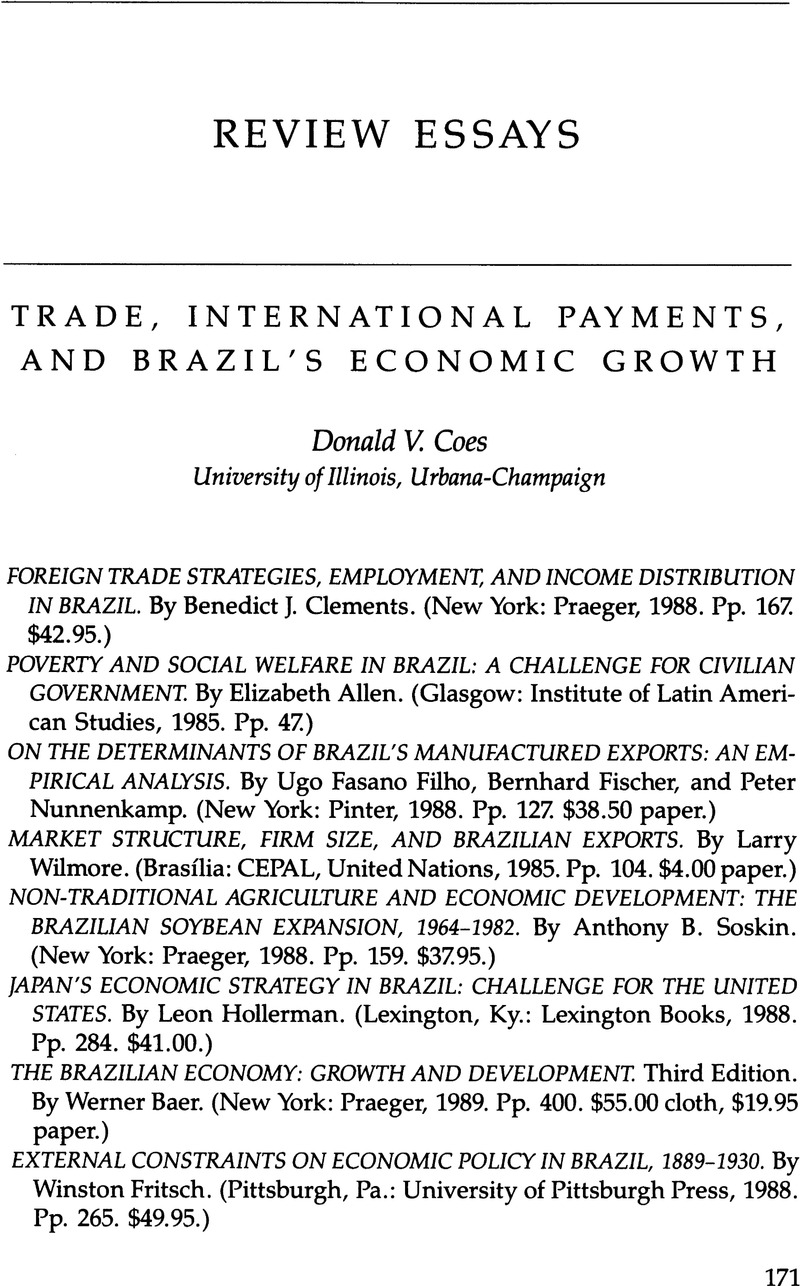Published online by Cambridge University Press: 12 October 2022

1. Brazilian usage of the term transfer problem differs significantly from the traditional American and British characterization, which referred to the effects on the terms of trade of an income transfer between countries rather than the transfer of real resources from the export sector to the indebted public sector within a country.
2. Notable among these efforts is Carlos Díaz Alejandro, “Stories of the 1930s for the 1980s,” in Financial Policies and the World Capital: The Problem of Latin American Countries, edited by Pedro Aspe Armella, Rudiger Dornbusch, and Maurice Obstfeld (Chicago, Ill.: University of Chicago Press, 1983).
3. Wolfgang F. Stolper and Paul A. Samuelson, “Protection and Real Wages,” Review of Economic Studies 9 (1941); reprinted in International Trade, edited by Jagdish Bhagwati (Harmondsworth, Middlesex: Penguin, 1969).
4. Wassily Leontieff, “Domestic Production and Foreign Trade: The American Capital Position Reexamined,” Proceedings of the American Philosophical Society 7 (1953); reprinted in Input-Output Economics, edited by Wassily Leontieff (London and New York: Oxford University Press, 1966).
5. Although modest during most of the 1980s by Mexican or Argentine standards, capital flight from Brazil is now significant and appears to have grown in the late 1980s as the perceived risk of a fall in the return to capital increased. Estimates of Brazilian capital flight have been made by Donald R. Lessard and John Williamson in Capital Flight and Third World Debt (Washington, D.C.: Institute for International Economics, 1987), and more recently by Arno Meyer and Maria Sílvia Bastos Marques in “A Fuga de Capital no Brasil,” manuscript prepared for the Fundação Getúlio Vargas in Rio, August 1989.
6. See, for example, the critical discussion of Brazilian income distribution in Albert Fish-low, “Brazilian Size Distribution of Income,” American Economic Review 62, no. 2 (May 1972): 391–402; and a subsequent attempt to explain the worsening trend by Gary Fields, “Who Benefits from Economic Development? A Reexamination of Brazilian Growth in the 1960s,” American Economic Review 67, no. 4 (Sept. 1977):570–82.
7. The Brazilian phrase is “aquela moça simpática que o governo paga para ter pena da gente.”
8. One of the first critical examinations of Brazilian industrialization policies and the potential limits to import substitution is found in Maria da Conceição Tavares, “The Growth and Decline of Import Substitution in Brazil,” Economic Bulletin for Latin America (Santiago: Economic Commission for Latin America, 1964).
9. William Tyler provides one of the most extensive analyses of the growth of Brazilian manufactured exports in Manufactured Export Expansion and Industrialization in Brazil (Tübingen, Germany: J. C. B. Mohr, 1976). Several specific aspects of the export promotion program have been examined by Afonso Celso Pastore, José A. A. Savasini, Joal de Azambuja Rosa, and Honório Kume in Promoção Efetiva das Exportações no Brasil (Rio de Janeiro: Fundação Centro de Estudos do Comércio Exterior, 1979); Eliana Cardoso, “Incentivos às Exportações de Manufaturas: Série Histórica,” Revista Brasileira de Economia: (Apr.–June 1980); and Alberto Musalem, “Política de Subsídios e Exportações de Manufaturados no Brasil,” Revista Brasileira de Economia (Jan.–Mar. 1981).
10. When industries were examined at a more disaggregated level, a weak but significant relationship between export growth rates and incentives appeared in the Fasano, Fischer, and Nunnenkamp study.
11. One such group of domestic-resource estimates shows large variations in the domestic resource costs by sector, with agricultural sectors generally being more efficient ways of earning foreign exchange than a number of highly protected industrial sectors. See José R. Mendonça de Barros, Helenamaria Lobato, Maria Angélica Travolo, and Maria Helena G. P. Zockun, “Sistema Fiscal e Incentivos às Exportações,” Revista Brasileira de Economia (Oct.–Dec. 1974).
12. Paul Krugman and Elhanan Helpman show how monopolistic competition may create a basis for trade. See Krugman, “Increasing Returns, Monopolistic Competition, and International Trade,” Journal of International Economics 9, no. 4 (Nov. 1979):469–80; and Helpman, “International Trade in the Presence of Product Differentiation, Economies of Scale, and Monopolistic Competition,” Journal of International Economics 11, no. 3 (Aug. 1981):305–40.
13. This material appeared earlier in Werner Baer and Paul Beckerman, “The Decline and Fall of Brazil's Cruzado,” LAR 24, no. 1 (1989):35–64.
14. Luiz Carlos Bresser Pereira and Yoshiaki Nakano, Inflação e Recessão (São Paulo: Editora Brasiliense, 1984). The roots of the “neostructuralist” tradition are deep in Brazil and include among others the work of Celso Furtado, Formação Econômica do Brasil (Rio de Janeiro: Fundo de Cultura, 1959); and Ignácio Rangel, A Inflação Brasileira (Rio de Janeiro: Tempo Brasileiro, 1963).
15. The inevitability of eventual inflation in the presence of a large government budget deficit is the focus of an influential theoretical analysis by Thomas Sargent and Neil Wallace, “Some Unpleasant Monetarist Arithmetic,” Federal Reserve Bank of Minneapolis Quarterly Review 5, no. 3 (Fall 1981):1–17. This analysis has been cited by “orthodox” (i.e., nonstructuralist) Brazilian economists.
16. This argument is developed in Celso Furtado, O Mito do Desenvolvimento Econômico (Rio de Janeiro: Editôra Paz e Terra, 1974).
17. Several recent attempts to explain why a society might choose a particular level of budget deficit are those of Alex Cukierman and Allan Meltzer, “A Political Theory of Government Debt and Deficits in a Neo-Ricardian Framework,” American Economic Review 79, no. 4 (Sept. 1989):713–32; and Guido Tabellini and Alberto Alesina, “Voting on the Budget Deficit,” American Economic Review 80, no. 1 (Mar. 1990):37–49.
18. Robert Triffen, “The Myth and Realities of the So-Called Gold Standard,” in Triffen, The Evolution of the International Monetary System (Princeton, N.J.: Princeton University Press, 1964).